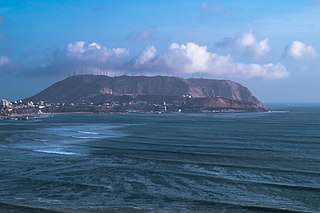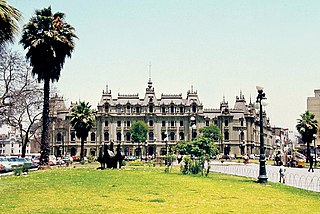
Chorrillos is a district of the Lima Province in Peru and part of the city of Lima. It gets its name from the Spanish word for "trickle of water". The district was founded as San Pedro de los Chorrillos and served as a deluxe beach resort until the late 19th century, when it was almost completely destroyed by Chilean forces during the War of the Pacific.

Barranco, founded in 1874 as San José de Surco, is one of 43 districts in Lima, Peru. Its current mayor is Jessica Vargas.

The Chorrillos Military School is the institution in charge of the undergraduate education of officers of the Peruvian Army.

The Battle of San Juan, also known as the Battle of San Juan and Chorrillos, was the first of two battles in the Lima Campaign during the War of the Pacific, and was fought on 13 January 1881. This battle is really a group of smaller, yet fierce confrontations at the defensive strongholds of Villa, Chorrillos, Santiago de Surco, San Juan de Miraflores, Santa Teresa and Morro Solar. The Chilean army led by Gen. Manuel Baquedano inflicted a harsh defeat on the Peruvian army commanded by the Supreme Chief Nicolás de Piérola. The Chilean triumph eliminated the first defensive line guarding Lima, and almost obliterated the Peruvian army defending it.

Morro Solar is a headland, situated in the district of Chorrillos, to the south of Lima, Peru. Morro Solar is notable for being a site of the Battle of San Juan and Chorrillos between Peruvian and Chilean forces in 1881. Notable landmarks include an astronomical observatory and a monument to an unknown soldier. Its geological formations are rich in silver which is being extracted by several mining companies.

The Plaza Bolognesi is a roundabout located in the Lima District and the Breña District, in the capital of Peru. It is located at the intersection of Brazil Avenue, Arica Avenue, Alfonso Ugarte Avenue, Guzmán Blanco Avenue, and 9 December Avenue.

The Lima campaign is the third land campaign of the War of the Pacific, carried out by Chile between December 1880 and January 1881. The campaign ended with the Chilean occupation of the Peruvian capital and the establishment of the Chilean authority in it and other surrounding territories, which would extend until 1883, with the end of the war.

The Palacio de la Magdalena is a viceregal house located in the district of Pueblo Libre in Lima. It is located near the Plaza de los Libertadores, and is also known as the Quinta de los Libertadores. The building was declared a national monument in 1972.

The National Club is a private club and civil association based in the Plaza San Martín of the Historic Centre of Lima. Founded on October 19, 1855, it has been the meeting place for the Peruvian aristocracy throughout the 19th and 20th centuries, as its members are members of the most distinguished and wealthy families in the country.

The Centennial of the Independence of Peru took place on July 28, 1921, as well as in December 9, 1924. To commemorate the hundred years of the country's independence from Spain, large and lavish parties supervised by President Augusto B. Leguía were held.

The Promenade of the Naval Heroes is a public park located in the historic centre of Lima. It occupies the first block of the Paseo de la República. It was given its current name on October 8, 1979 in commemoration of the centenary of the battle of Angamos.

The Plaza Manco Cápac, formerly the Plaza Leguía, is a public square in Lima. Formerly named after president Augusto B. Leguía, its current name comes from Manco Cápac, the first Sapa Inca of Cuzco.

The Monument to Manco Cápac is a statue located in the homonymous square in La Victoria District, Lima, the work of the Peruvian sculptor David Lozano, inaugurated in 1926.

The Moorish Arch, also called the Friendship Arch or Spanish Arch, was a triumphal arch installed at the beginning of Leguía Avenue in Lima, Peru. It was made in a neo-Moorish style, inaugurated in 1924 as part of the Centennial of the Independence of Peru and demolished in 1939.

The Statue of Liberty is a bronze sculpture located in the Plaza Francia of the historic centre of Lima, Peru. It was made in 1926 according to the design of the French sculptor René Bertrand-Boutée and cast by Eugène Soleau. It is a one-piece bronze sculpture about 2 metres high and represents a standing female figure, dressed in a light tunic and with a laurel wreath on her head. This is installed on a 4.30 m high pedestal. The sculpture and the Plaza Francia were declared a monumental urban environment in 1972. In 2018, La Libertad was declared Cultural Heritage of the Nation.

The Monumental Museum of the District Municipality of Huanta, also known simply as the Huaura Balcony, is a war museum located in the Peruvian city of Huaura, dedicated to the memory of José de San Martín and the Liberating Expedition of Peru. The museum is housed in a Viceregal house that originally belonged to the Royal Customs of Lima. It was declared a historical monument by Law No. 9636 of October 28, 1942.

The Quinta de Presa is a French-style country mansion built in the 18th century during the government of the then viceroy of Peru, Manuel de Amat y Junyent. It comprises a constructed area of 15,159 square metres (163,170 sq ft). It is located in the jirón Chira of the Rímac district, Lima, Peru.

The Officers' School of the National Police of Peru is a police academy in charge of training law enforcement recruits in Peru. It is based in the Chorrillos District of Lima, and is considered the alma mater of the police officers of the country. Training at the school is carried out for 5 years, with the first year of education being carried out as an aspiring cadet and the remaining 4 years as a cadet.

The Parque Reducto No. 2 is a 20,000 m2 public park located at the intersections of Benavides and Luis Bedoya Reyes avenues, in Miraflores District, Lima, Peru. Located in a former redoubt built by the Peruvian Army during the War of the Pacific, it was declared a National Monument in 1944, and a Patriotic Sanctuary in 1965.

José Castro Mendivil Digital Planetarium, also known simply as the Morro Solar Planetarium, is a planetarium and site museum dedicated to astronomy in the Morro Solar of Chorrillos District, Lima, Peru. It is named after the engineer who designed it.





















